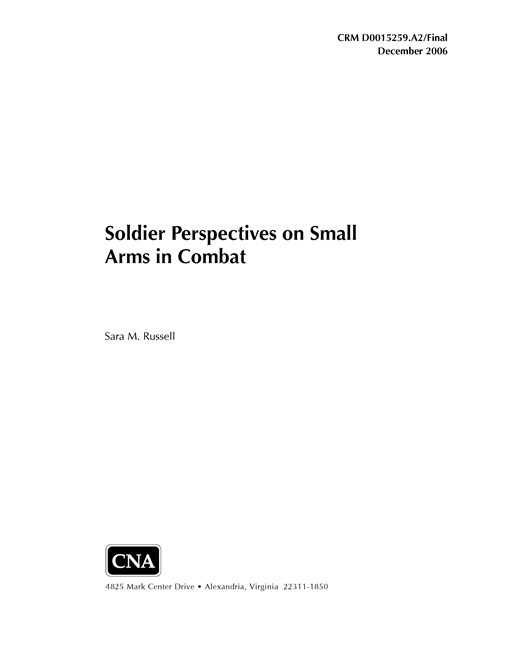Project Manager Soldier Weapons (PMSW) supports soldiers through the development and procurement of weapon systems, ammunition, and other associated target acquisition/fire control products. During Operation Iraqi Freedom (OIF) and Operation Enduring Freedom (OEF), individual soldiers have raised concerns with their small arms in combat. The Army would like to obtain a much broader understanding of soldiers’ views of their small arms.
This study assessed soldier perspectives on the reliability and durability of their weapon systems in combat to aid in decisions regard- ing current and future small arms needs of the Army. The weapons examined in this study were the M9 pistol, M4 and M16 (A2 and A4) rifles, and the M249 light machine gun. These four weapon sys- tems are the standard issue individual weapons being used by Army soldiers in Iraq and Afghanistan. Weapon reliability is defined as soldier level of confidence that their weapon will fire without stoppage in the combat environment. Weapon durability is defined as soldier level of confidence that their weapon will not suffer breakage or failure that necessitates repair before further use.
CNA conducted over 2,600 surveys with soldiers who had returned from Iraq or Afghanistan within the previous 12 months and had engaged in a firefight using the M9, M4, M16 (A2 or A4), or M249 during their last deployment. The survey covered key issues related to weapon reliability and durability including training and experi- ence, weapon maintenance/cleaning, weapon stoppages, accessories, and environment. In addition, the survey assessed soldier satisfaction levels with the weapon systems and related components.
Most soldiers indicate satisfaction & confidence in the reliability and durability of their weapons. Levels of satisfaction and confidence with the M9 and M249 are consistently lower than for the other weapons. Soldiers reported being most satisfied with the M4 and least satisfied with the M9. This trend was found with regard to satisfaction with weapon accessories, maintainability, training, cleaning equipment, ammunition, corrosion resistance, accuracy, smoke/noise/flash, range, and rate of fire. High levels of confi- dence were attributed to soldier maintenance and low levels of con- fidence were attributed to weaponage, stoppages, and difficulty in maintaining the weapon.
Soldiers reported being most satisfied with the handling qualities of the M4. Handling qualities include weapon grips/handguards, heat, size, and weight. The size of the M16 and the weight of the M249 are most often cited as the reason for dissatisfaction with the weapon’s handling qualities. The grips/handguards of the M9 and M4 are cited as a major reason for dissatisfaction with weapon handling.
When soldiers were asked if they experienced a weapon stoppage at any time during an engagement in theater, they reported the most stoppages with the M9 (26 percent) and the M249 (30 percent). Most stoppages were reported to have a small impact on continuing in the engagement with the weapon. The impacts of stoppages ex- perienced were reported to be most serious with the M9 and M249. A large impact is the inability to engage the target with the weapon during a significant portion or entire firefight after performing immediate and remedial action to clear the stoppage. A small impact is the ability to engage the target with the weapon after performing immediate or remedial action to clear the stoppage. Over fifty percent of soldiers utilizing the M4 and M16 reported that they never experienced a stoppage while in theater (this finding includes stoppages during an entire deployment and is therefore not limited to firefights and includes training).
Statistical models were estimated to identify individual effects while holding other factors constant and establish the statistical significance of factors contributing to soldier confidence in weapon reliability, durability, repairs, and stoppages.
In most cases, attaching accessories using methods of attachment other than rails has negative impact with regard to weapon stop- pages, repairs, and confidence in reliability and durability.
Download reportApproved for Public Release; Distribution Unlimited. Specific authority: N00014-05-D-0500.
Details
- Pages: 50
- Document Number: CRM D0015259.A2/Final
- Publication Date: 12/1/2006
